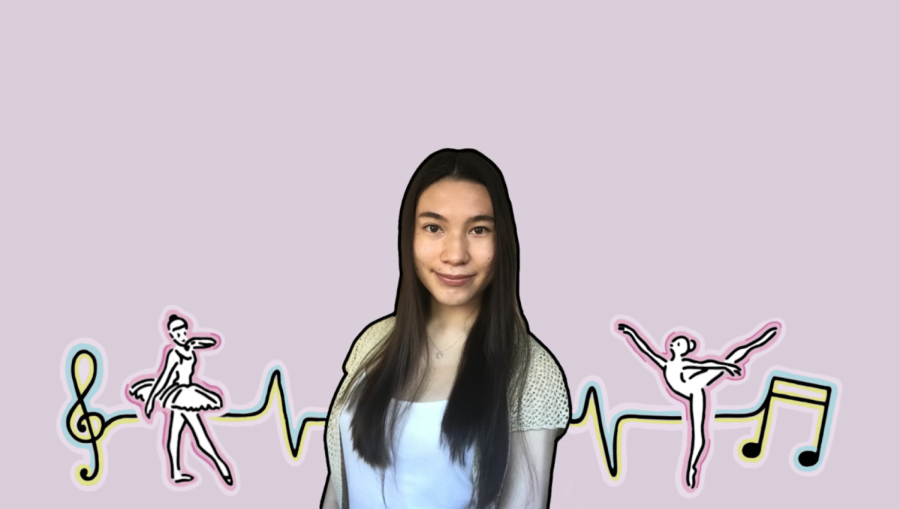Reclaiming my love for ballet
Graphic Illustration and Photo by Emma Constable
Although the pandemic has forced me to transition from dancing late nights at the studio to a confined space at home, it has also led me to reevaluate and rediscover my passion for ballet.
May 26, 2021
“Stop,” my ballet teacher interjected, abruptly turning off the music. I felt my heart sink, knowing she was going to tell me off for doing something wrong.
“Emma, you can’t just stand there before the music begins. You should already be thinking about your posture, your core, your arms…”
Her words blurred into the background as the other girls turned to look at me — not directly, but through the mirror — which made it even worse because they almost seemed to be enjoying my humiliation.
I nodded mutely and made the correction, feeling my face start to burn. Great, you already messed up. This was the voice that directed me throughout the rest of the two-minute exercise. Not my teacher’s, and not the soft notes of the piano ballade — this voice was stinging, harsh and remorseless, and the worst part was that I had gotten used to it.
My journey in ballet hadn’t always been consumed by such negative thoughts. In fact, when I first began at the age of five, I loved nothing more than dressing up in my pink leotard and enjoying the 10 minute drive to the dance studio, where I could spend hours twirling about.
Although my teachers’ expectations of maturity and personal growth inevitably increased as I grew older, I never lost my childhood spirit and admiration for the dance style. I’ve always loved ballet because every movement is deliberate and requires incredible focus, not to mention years of offstage preparation and discipline, even though a good dancer makes a performance appear effortless from the audience’s perspective.
More importantly, I loved not only watching ballet but also getting to experience it for myself. My teachers were strict but supportive, and although I was shy and didn’t have many friends, I looked forward to my classes each week. Almost all the other girls immersed themselves in other styles of dance such as jazz, tap, contemporary and lyrical, but I was content to stick with the one I knew best. Despite having less exposure to different dance forms and techniques, I never worried about how my classmates perceived me or how good I was compared to them.
My first major accomplishment was putting on my first pair of pointe shoes and consequently transitioning into the world of “real” ballet — the kind that automatically comes to mind when most people hear the word. I was beyond excited to finally reach the milestone I’d dreamed of since I was little, and going en pointe for the very first time still stands out in my mind as one of my proudest moments.
With the extra classes and hours of training I was required to take following this transition, I quickly learned first-hand that beauty is only skin-deep when it comes to pointework. The beautifully sculpted shoes, shiny ribbons and impressive poses completely masked the pain and perseverance that went into every one of my movements. Although I often left the studio exhausted and sore, I still loved what I was doing. There was nothing like the weightless feeling of gliding across the floor on the tips of my toes, perfecting a flawless pirouette after countless attempts and eliciting a word of praise from my teacher.
It was only when I entered high school that my unconditional love for ballet began to waver. Naturally, entering Lynbrook as an high-achieving perfectionist had already set me up for the self-imposed academic pressure that still burdens me as a junior, and, unfortunately, that desperate need to succeed followed me into the studio. I began to receive more critiques on a regular basis from my teachers than I was used to, and although this was only because expectations were higher in more advanced levels, I took this as a sign of failure. Instead of feeling encouraged to improve on my technique, I was embarrassed that I wasn’t already doing it perfectly. Instead of moving on from my mistakes, I dwelled on them and berated myself. My internal dialogue might not have been so negative had my classmates also received critiques as frequently as I did, but as they all spent more time at the studio, inevitably they were more experienced — which is something I should have acknowledged and respected instead of felt threatened by.
I’ve always pushed myself hard in everything I do, especially things that I’m passionate about, but ballet quickly came to overwhelm me as it turned into an extension of the stress and pressure that already consumed me at school. It was supposed to be fun, but it had become yet another competition in my mind where I was constantly comparing myself to others. I felt like a black swan among my classmates who always seemed so much more confident and put together than me. I constantly felt exposed before the giant wall-sized mirror, paranoid that someone was watching my every stumble. My irrational fear of failure even led me to ignore warning signs of pain and injury, which only resulted in serious consequences that set me back even further.
When the COVID-19 pandemic hit, I was the most unmotivated I had ever felt about ballet because I was always frustrated and unhappy with myself; it seemed as though there wasn’t a moment in the day when I didn’t have to please someone — although this person was namely me. While many other students were hit extremely hard by the abrupt transition to remote school and cancellation of athletics, I felt as if a huge weight had been lifted off my shoulders. Being able to dance in the comfort of my home, separated by a screen from the competitive environment that had begun to tear me apart, allowed me to enjoy ballet once again because I could finally be myself. My motivation to attend class returned, and I could breathe easy knowing no one except for my teachers were watching me on Zoom.
However, I also felt a simultaneous sense of guilt at my relief. Everyone else seemed to be suffering without sports practices and the chance to see their friends, while I was secretly happy that I was no longer obligated to stay late nights at the studio. Ballet was supposed to be something I loved, so why was I grateful that the pandemic had relegated it to a small screen in the corner of my living room, punctuated by the static of poor connection instead of the comforting beat of the music?
As I continued to attend ballet virtually throughout the year, I began to lose motivation again, but this time it was due to an utter lack of competition. Without anyone to compare myself to, I didn’t feel a need to push myself to improve. I came to realize that I lacked balance. While my tendency to compare myself to others had previously led to an unhealthy, toxic mindset, I wasn’t benefitting either from a total absence of pressure. Knowing that my goal was to both improve and enjoy ballet, I shifted my perspective and imagined myself dancing in-person again with the other girls so that I could envision progress and actually achieve it. And when I made this my goal instead of setting unrealistic standards for myself, I finally found the balance I had been searching for.
Ultimately, I should have realized that pushing myself to such unrealistic standards would have resulted in burnout, and forcing myself past the boundaries of pain and mental exhaustion was extremely unwise. While I still struggle sometimes to keep my competitive, perfectionist mindset in check, I’ve learned to be kinder to myself and recognize that I am the only person I should seek to please when I dance. I might not be the best ballet dancer, but I do have the determination to work toward new achievements. I only have a little over a year left at my studio, so now that I can trust myself to prioritize my own progress over others’ opinions and judgement, I can fully and fearlessly reclaim my love for ballet.



































































